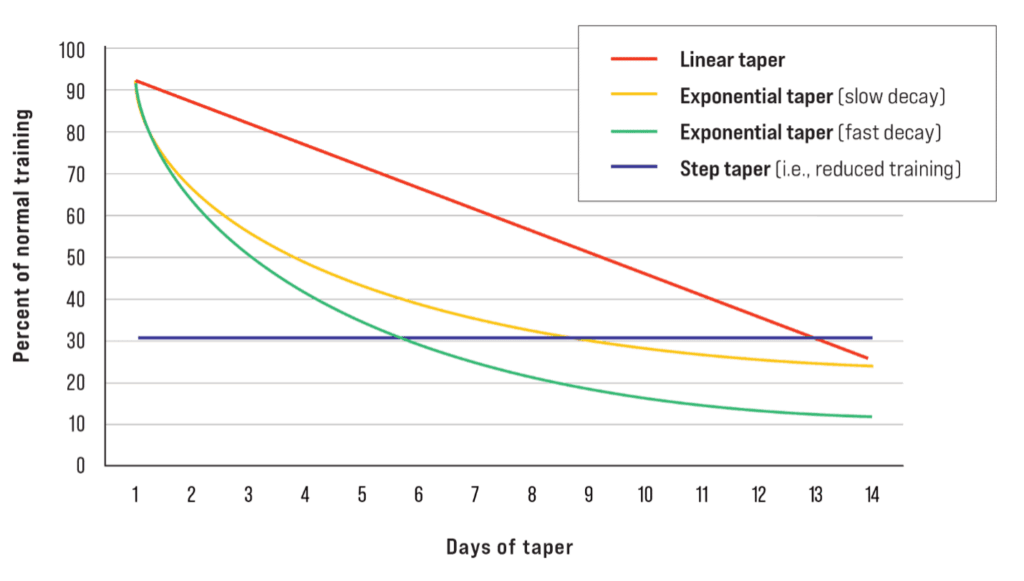
You’ve been hitting the gym consistently, building strength to support your running. But now your race is coming up and you’re wondering if you should keep lifting as usual, ease off, or stop completely?
The short answer: you should taper your strength training, just like you taper your running. Done right, this can help you feel fresh and explosive on race day without losing the strength you’ve worked so hard to build.
Why Taper Strength Training Before a Race?
Strength training is a fantastic tool for runners. It builds tissue capacity, improves running economy, and reduces injury risk. But just like the load from your running training, it is important to reduce your training load in the gym when tapering for a race.
Heavy lifting creates muscle damage, central nervous system fatigue, and sometimes delayed onset muscle soreness (DOMS). All of which are normal parts of the muscle-building process and are necessary in getting us stronger.
In the week or two before your race, your goal shifts from building fitness to preserving it while reducing fatigue. That means you still want to stimulate your muscles but without creating lingering fatigue or soreness that could blunt your performance.
Think of it like this:
- Too much lifting close to race day = heavy legs, slower turnover, fatigue and poor performance
- Too little lifting for too long = loss of neuromuscular sharpness and power

Linear Taper
Training volume is reduced gradually and evenly each day or week until race day.
Exponential Taper
Training volume decreases in a curved fashion – either fast at the start (fast exponential) or slow at the start and faster closer to race (slow exponential).
Step Taper
Training volume is reduced abruptly in one step, then held steady until the race.
How Long Should You Taper Before Your Race?
The length of your taper depends on:
- Race distance – Longer races (e.g., marathon/ultra) often benefit from a longer taper, while shorter races may need less.
- Usual lifting load – The heavier or more frequent your strength training, the more you need to reduce it before race day.
- Your goal – If this race is a priority you will want to ensure your legs are fresh and ready to go but if it is more of a training race, or less important to you, the taper can be shorter and less aggressive.
As a general guide:
- For a half marathon or shorter: 5–7 days of tapered strength training is usually enough.
- For a marathon or ultra: 7–10 days of tapered strength training can help ensure your legs are fully fresh.
How to Adjust Your Strength Training in a Taper
1. Keep the Movement, Reduce the Reps
Maintain similar exercises you’ve been doing e.g. squats, deadlifts, lunges and step-ups but reduce the reps by 40-60%. Don’t try anything new or go heavier than usual!
2. Control the tempo
Heavy, slow eccentrics (e.g. lowering phase in a squat) are fantastic for building strength but also increase DOMS (delayed onset muscle soreness) compared to regular tempo movements. During the taper it would be wise to keep time under tension low and therefore potential muscle soreness.
3. Manage the Range of Motion
Usually, moving through full ranges of motion e.g. deep squats, full range deadlifts etc. is a fantastic way to increase strength but also accumulates a lot of fatigue. During your taper it is advised to reduce this range by squatting to a bench and doing partial range deadlifts for example.
4. Include “Priming” Sessions
About 3–4 days before the race, a short strength session with moderate weight and explosive intent can help maintain neuromuscular sharpness. Think light squats, kettlebell swings, or box jumps at a low volume.
5. Stop Heavy Lifting 3–5 Days Before the Race
This allows recovery from any residual muscle damage and ensures your central nervous system is fresh. Light mobility and activation work can continue right up to race day.
Example Taper Week
If you usually lift twice a week:
| MONDAY | Moderate load full-body strength session – keep it short (30–40 min), 2–3 sets per exercise, 6-8 reps. |
| WEDNESDAY | Light activation session – bodyweight or light resistance bands, mobility, and short explosive drills. |
| THURSDAY-SATURDAY | No heavy lifting; focus on low volume light movement e.g. short walks and rest |
| SUNDAY | Race day! |
Common Mistakes to Avoid
- Cutting strength training completely for 2+ weeks – You risk feeling flat and losing some neuromuscular benefits.
- Doing a “last heavy session” too close to the race – You won’t gain extra strength, but you may gain soreness.
- Trying new exercises – This is the quickest way to get sore in the taper week. Stick to what’s familiar.
Key Takeaways For Strength Tapering With Running
Tapering strength training before a race isn’t about ditching the weights, it’s about fine-tuning them. Keep the movements your body knows, drop the volume and intensity, and time your last moderate session far enough out so you get to the start line feeling light, fresh, and ready to run your best.
Frequently Asked Questions – Tapering Strength Session
Should I taper my strength training before a running event?
Yes! The research tells us that tapering both our running and strength volume leads to improvements in performance. The key is that tapering reduces accumulated fatigue while still maintaining the adaptations you’ve worked hard to build.
When you lift weights, especially heavy weights, at high volumes or through deep ranges of motion, you create muscle damage, neural fatigue, and sometimes residual soreness. This is useful for adaptation in training blocks, but in the final weeks before a race, it can blunt your running performance. By tapering your strength training, just like you taper your running mileage; you allow the body to fully recover and express peak performance on race day.
What are the benefits of tapering?
- Reduction in fatigue and muscle soreness which leads to a feeling of “fresh legs” which can have both a physical and mental improvement on performance
- Helps to maintain strength and power development built throughout the training block
- Ensures that the running-based taper isn’t interfered with or affected by strength training
Should I just stop lifting all together a few weeks out?
Research shows that complete cessation of strength training for more than 14 days may reduce power output which may have a negative impact on performance. There is no need to completely stop your strength training, a reduction in volume is all that is required to be race-ready.
How long should I taper for?
This depends on your current training levels, experience and the type of race you’re doing. Typically, strength tapers may be shorter than the running taper. For example, for a 5-10km race might only require 3-5 days of reduced volume in the gym
What are the risks of not tapering?
Your performance may be affected if you turn up to race day feeling fatigued, flat or sore. Taking a few days to pull back on both your strength and running training before your race could be all the difference between a PB or not. While there are no extreme “risks”, you are simply leaving seconds, or minutes on the table!

